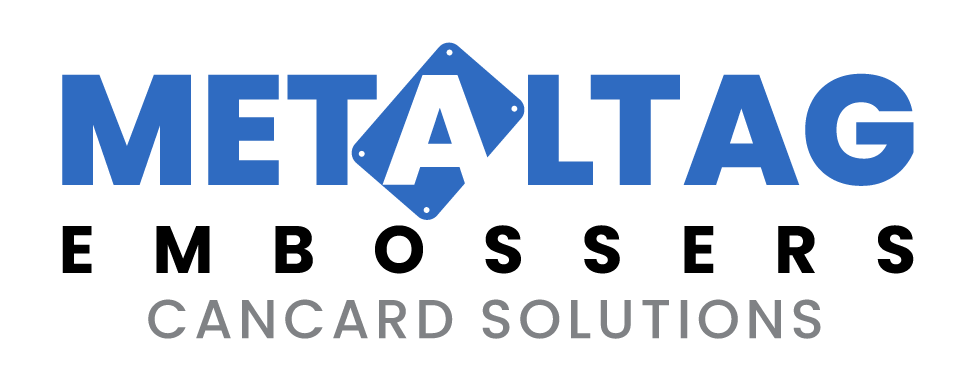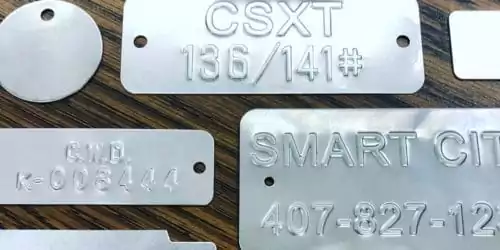Ever wondered why industrial nameplates, machinery tags, and outdoor metal signs remain readable for decades — even under harsh conditions? The secret lies in the marking process.
Two of the most reliable metal marking methods are embossing and engraving.
While both provide long-lasting results, understanding the difference between embossed and engraved metal tags helps you choose the best option for your application — whether it’s durability, customization, or cost efficiency.
What Is Embossing?
Embossing is a mechanical marking process that uses a male-female die set to press raised designs or characters onto a metal surface. Instead of cutting into the material, it pushes the design upward, creating raised text that’s easy to see and feel.
Advantages of Embossing
- High Durability: Raised characters resist scratching, corrosion, and paint coverage.
- High Visibility: Text remains legible even when dirty or worn.
- Cost-Effective for Bulk Orders: One die can produce thousands of identical tags.
- Great for Outdoor Use: Withstands UV rays, rain, oil, and extreme temperatures.
Common Applications
- Safety release valve tags
- Metal asset labels
- Utility pole markers
- Pipeline and machinery identification
Suitable Materials
- Aluminum: Lightweight, corrosion-resistant, and color-customizable through anodization.
- Stainless Steel: Strong and weatherproof — ideal for heavy-duty environments.
- Painted Steel: Offers both durability and visual contrast.
Pro Tip: Use anodized aluminum if you need color-coded embossed tags for equipment classification.
What Is Engraving?
Engraving is the process of etching or cutting designs directly into the surface of a metal plate using a precision tool or laser. Instead of raising the text, engraving creates deep, indented markings that are permanent and highly precise.
Advantages of Engraving
- High Precision: Perfect for intricate logos, barcodes, and serial numbers.
- Customizable: Each tag can have a unique design or code.
- No Ink or Printing: The design is physically cut into the metal, so it won’t fade.
- Professional Finish: Ideal for branded or aesthetic applications.
Limitations
- Slower for Large Runs: Each tag must be individually engraved.
- Requires Thicker Metal: Deep cuts may weaken thin materials.
- Higher Cost: More suitable for low- to medium-quantity orders.
Industries Using Engraving
- Telecommunications
- Aerospace and Defense
- Energy and Utilities
- Industrial Equipment Manufacturing
Embossed vs Engraved: Key Differences
| Feature | Embossing | Engraving |
| Appearance | Raised text/design | Indented/cut-in design |
| Durability | Extremely high; resists wear and paint | Very high; resists fading and chemicals |
| Production Speed | Fast (bulk manufacturing) | Slow (individual cutting) |
| Customization | Limited — new die needed for each design | Unlimited — each tag can differ |
| Cost Efficiency | Best for large orders | Better for small, detailed runs |
| Material Requirement | Thin or medium metal | Thicker metal required |
| Best For | Industrial tagging, mass production | Precision designs, small batches |
In short: Choose embossing for volume and durability, and engraving for customization and precision.
Which Is More Durable?
Both methods are incredibly strong, but embossing has a slight edge in long-term durability — especially outdoors.
Because embossed characters are raised, they remain legible even if the tag gets scratched, painted over, or dirty.
Engraved designs, though also permanent, can collect debris inside their grooves and may fade slightly over many years in extreme environments.
Best Materials for Metal Nameplates
| Material | Durability | Features | Ideal For |
| Aluminum | High | Lightweight, rust-proof | Color-coded or lightweight tags |
| Stainless Steel | Very High | Heat and corrosion resistant | Outdoor & heavy-duty tags |
| Brass | Medium | Conductive, premium look | Electrical or aesthetic applications |
Tip: For environments exposed to chemicals or extreme weather, stainless steel embossed tags last the longest.
Choosing the Right Process
When deciding between embossing and engraving, consider:
- Quantity: Embossing is faster and cheaper for bulk runs.
- Design Complexity: Engraving offers more flexibility.
- Environment: Embossing is better for outdoor durability.
- Budget: Engraving costs more per unit but suits low-volume needs.
For most industrial applications where reliability is key, embossed tags deliver unmatched long-term performance.
Frequently Asked Questions
Embossed tags generally last longer in outdoor and industrial conditions due to their raised characters.
Yes! Anodized aluminum tags can be colorized while retaining the raised text.
Yes, engraving offers full customization and precision, ideal for short runs or unique designs.
Aluminum and stainless steel are most popular due to their strength, corrosion resistance, and readability.
Conclusion
Both embossing and engraving are trusted, high-quality marking methods — each with its unique strengths. If you need high-volume, weatherproof, and long-lasting tags, go with embossing.
If you need custom, detailed, or branded tags, engraving is the better fit.

